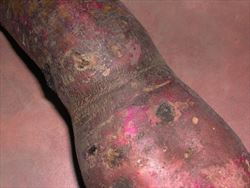- Narrow. East Africa. Major disease of sweet potato caused by two viruses interacting - Sweet potato chlorotic stunt virus (SPCSV) and Sweet potato feathery mottle virus (SPFMV). On their own, they do relatedly little harm (see Fact Sheets nos. 375, 258).
- SPCSV allows SPFMV to multiply many times more than when alone.
- Symptoms are variable: leaves with yellow blotches, mosaics, mottles, deformed; vines stunted. Yields of storage roots low, depending on time of infection and variety. Impact - farmers forced to grow low-yielding resistant varieties.
- Spread: SPCSV by whiteflies; SPFMV by aphids. Also, in cuttings for propagation. Over longer distances, storage roots sent to markets. Viruses survive between crops in vines left in fields, in storage roots used for spouts, and in wild Ipomoea (morning glory).
- Biosecurity: risk from different virus strains and unofficial introductions of vines/storage roots. Official movement of germplasm should always follow the FAO/IPBGR Technical Guidelines.
- Biocontrol: none.
- Cultural control: carefully select planting material – if unsure establish nursery from cuttings or storage roots and use the sprouts; plant new plots >15m (distance whiteflies fly) away from old crops (with barrier crops between, e.g., maize); avoid planting downwind from old plots; rogue diseased plants during first month from planting; collect vines after harvest and bury, burn or compost; avoid planting in same field as previous crop (unharvested storage roots provide source of viruses). Use local or NASPOT varieties selected or bred for tolerance.
- Chemical control: not an appropriate method.
Pacific Pests, Pathogens and Weeds - Online edition
Pacific Pests, Pathogens, Weeds & Pesticides
Sweetpotato virus disease (528)
Sweetpotato virus disease.
Sweet potato chlorotic stunt virus and Sweet potato feathery mottle virus interact to cause sweet potato virus disease. There are different strains of both viruses in East Africa, and differences between the strains there and those elsewhere in Africa. The abbreviation of the disease is SPVD, and for the two viruses the abbreviations are SPCSV (see Fact Sheet no. 375) and SPFMV (see Fact Sheet no. 258), respectively. SPCSV belongs to the genus Crinivirus; SPFMV belongs to the genus Potyvirus.
AUTHOR Grahame Jackson
Information from Gibson RW, et al. (1998) Identification of the East African strain of sweet potato chlorotic stunt virus as a major component of sweet potato virus disease in Southern Africa. Plant Disease, 82(9): 1063; and Gibson RW, et al. (1998) Symptoms, aetiology and serological analysis of sweet potato virus disease in Uganda. Plant Pathology, 47(1): 95-102; and Clark CA, et al. (2012) Sweet potato viruses: 15 years of progress on understanding and managing complex diseases. Plant Disease 96(2):168-185. (http://apsjournals.apsnet.org/doi/pdfplus/10.1094/PDIS-07-11-0550); and Internal cork disease of sweet potato (Sweet potato feathery mottle virus). Plantwise Knowledge Bank. (http://www.plantwise.org/KnowledgeBank/Datasheet.aspx?dsid=50963); and O’Sullivan, et al. (Undated) Sweet potato virus disease. Sweet potato DiagNotes: A diagnostic key and information tool for sweet potato problems. (http://keys.lucidcentral.org/keys/sweetpotato/key/Sweetpotato%20Diagnotes/Media/Html/FrontPage/Index.htm); and Sweet potato virus disease. CABI Crop Protection Compendium. (http://www.cabi.org.ezproxy.library.uq.edu.au/cpc/datasheetreport?dsid=18603); and from Moyer JW, et al. (1989) FAO/IBPGR Technical Guidelines for the Safe Movement of Sweet Potato Germplasm. Food and Agriculture Organization of the United Nations, Rome/International Board of Plant Genetic Resources. Photos 1&2 Richard Gibson, Plant Psthologist, Natural Resources Institute, University of Greenwish, UK. Photo 4 Gerald Holmes, Strawberrry Center, Cal Poly San Luis Obispo, Bugwood.org.
Produced with support from the Australian Centre for International Agricultural Research under project HORT/2016/185: Responding to emerging pest and disease threats to horticulture in the Pacific islands, implemented by the University of Queensland, in association with the Pacific Community.







